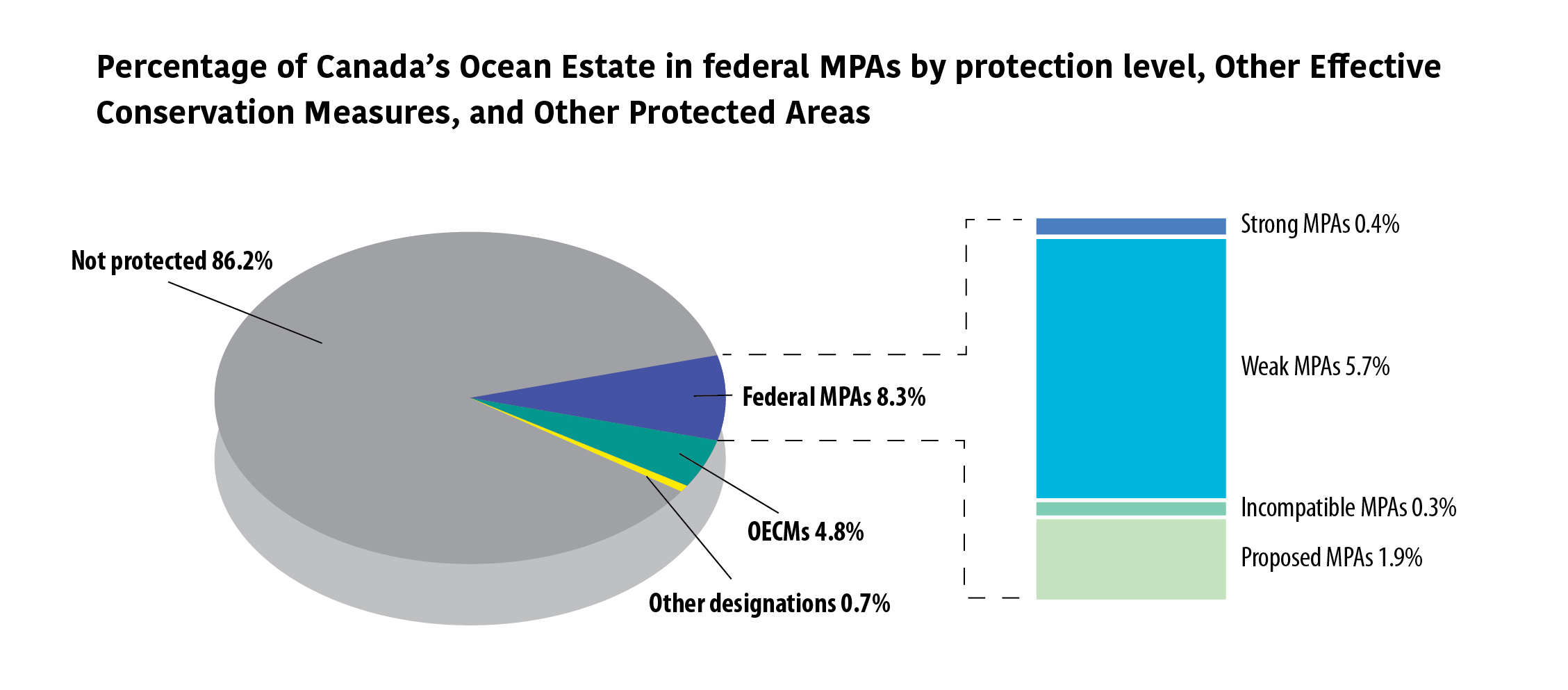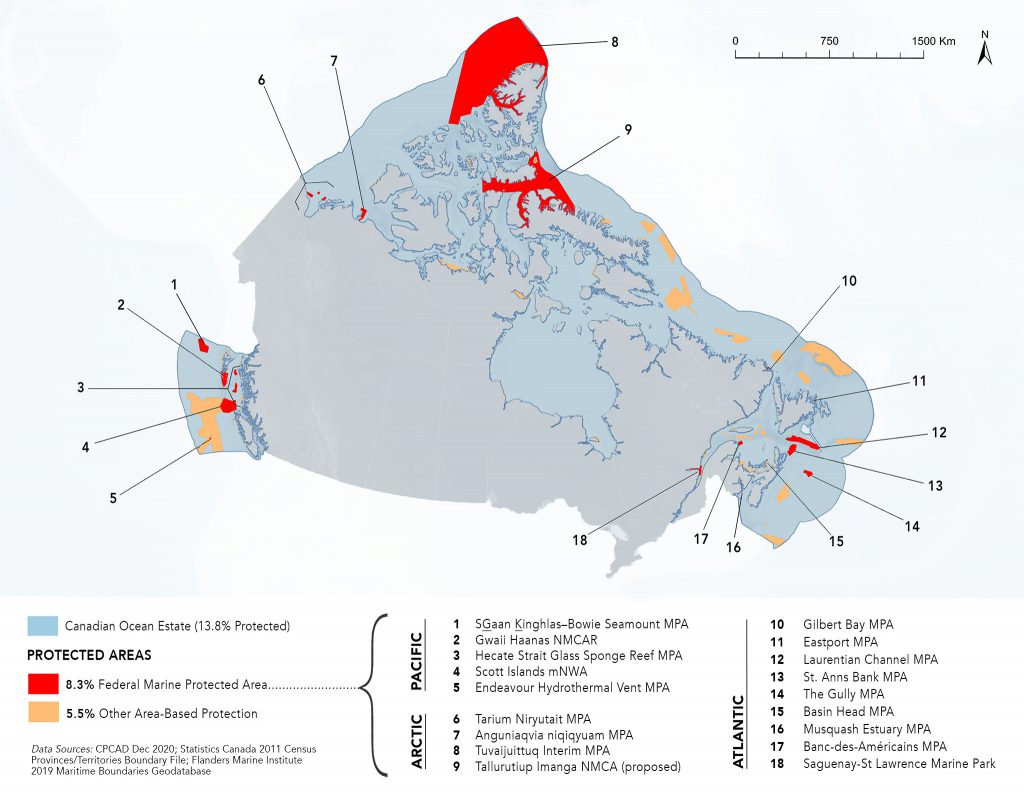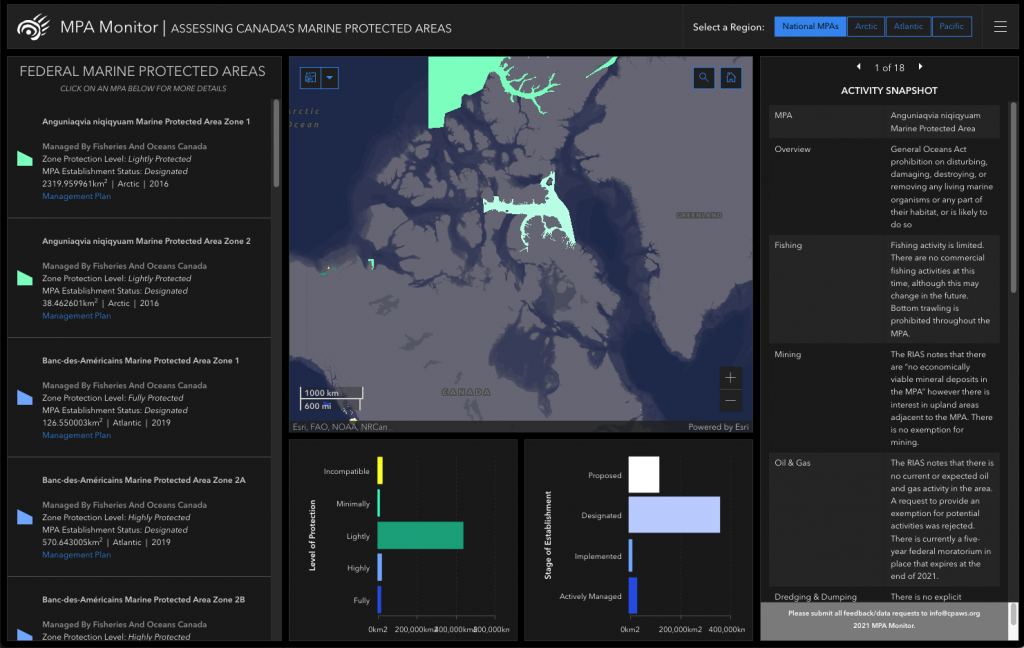We are excited to announce the release of the MPA Monitor: Assessing Canada’s Marine Protected Areas – a detailed report that investigates how well protected and well managed Canada’s Marine Protected Areas (MPAs) really are.
Presently, almost 14% of Canada’s ocean is protected and the country is committed to protecting 25% by 2025 and 30% by 2030. We analysed about half of the protected areas and found that the majority is weakly protected.
CPAWS is the first organization to use a ground-breaking new MPA evaluation tool, The MPA Guide, to examine 18 MPAs that make up 8.3% of Canada’s ocean.
Our analysis indicates that seven of Canada’s 18 federal MPAs are strongly protected, eight are weakly protected, two are incompatible with biodiversity conservation, and one is proposed but not yet established. We also found considerable regional differences in protection levels, with the more strongly protected MPAs in Atlantic Canada, large but weakly protected MPAs in the Arctic, and several weaknesses in MPAs in the Pacific.
When size is considered, these sites contribute only 0.4 % of Canada’s ocean in strongly protected federal MPAs, 5.7 % in weakly protected federal MPAs, and 0.3 % in MPAs that are incompatible with conservation. The proposed site covers 1.9% of Canada’s ocean.

While Canada has made progress on ocean protection, there is much to be done to improve the quality of protection to maximize conservation benefits. Most significantly, for an MPA to be successful, Enabling Conditions, such as equitable governance and strong conservation objectives, must be in place. Indigenous-led conservation and co-management models are critical to the future of marine conservation in Canada.

Executive Summary
As the result of more than 100 years of industrial use and over-exploitation, the ocean is facing a biodiversity crisis that will have far-reaching impacts, not just for nature but also for human health and wellbeing the world over. In Canada, fisheries are edging closer to collapse, iconic species are teetering on the edge of extinction, and vital ecosystems like eelgrass and deep-sea coral and sponge reefs are disappearing. Science tells us that if we are going to reverse these declines, we must act now. Marine protected areas (MPAs) are recognized as one of the most effective tools to protect ocean ecosystems, rebuild biodiversity, and help species adapt to climate change.
Interactive Dashboard
- Canadian Geographic — Marine protected areas in Canada may not be as protected as we think
- Whale Seeker — Beyond 30×30 – Meaningful management of marine protected areas
- Ha-Shilth-Sa — Nations want swift resolution marine protected area talks
- Mountain Equipment Company — Giving back to the outdoors
- Toronto Star — Canada’s marine protected areas aren’t as safe as you think
- Toronto Star — Canada must lead in fight against climate change and loss of biodiversity
- Canada’s National Observer — 200 nature groups urge Trudeau to ‘get it right’
- Canada’s National Observer — Canada’s marine protected areas aren’t as safe as you think
- The Narwhal — Canada’s marine parks are still threatened by oil and gas, trawling: report (thenarwhal.ca)
- La Presse — Une pêche « destructrice » dans une aire marine protégée
- Campbell River Mirror — CPAWS: B.C. marine parks ability to protect biodiversity a “mixed bag”
- Pew — Most Marine Protected Areas in Canada Have Room for Improvement
- The Hill Times — Canada needs better protection for its ocean-protected areas, says new report
- 2021 Oceans Report
- The MPA Guide: A Framework to Achieve Global Goals for the Ocean provides a novel science-based framework to consistently plan, establish, and track MPAs and their outcomes for both biodiversity and human well-being.
- Evidence shows that at least 30%, and as much as 70% or more, of ecosystems need to be conserved to reverse nature’s decline and safeguard a healthy planet for people and nature. This is consistent with CPAWS’ long-standing goal of protecting at least half of Canada’s ocean, public land and fresh water.
- A recent paper summarizes the benefits of effective and strongly protected MPAs, including increasing fish biomass by 600% and helping to mitigate climate change and its effects. Research recently published in Nature calculated that protecting 30% of the ocean in strong MPAs could help to restore ocean ecosystems as soon as 2050, with significant economic benefits.
- In response to recommendations from a National Advisory Panel on Marine Protected Area Standards, Canada announced its commitment to establish minimum protection standards for all federally designated MPAs in April 2019.
- In June 2020, Canada joined the Global Ocean Alliance and committed to protect 30% of its ocean by 2030. In September 2020, Canada joined the High Ambition Coalition (HAC) for Nature and People, reiterating this commitment.
- Learn more about CPAWS work to support the establishment of Marine Protected Areas in Canada.
For more information or to arrange an interview, please contact:
Jennifer (Jenn) Brown
Communications and Events Coordinator, National Ocean Program, CPAWS
[email protected]
416-389-6668


